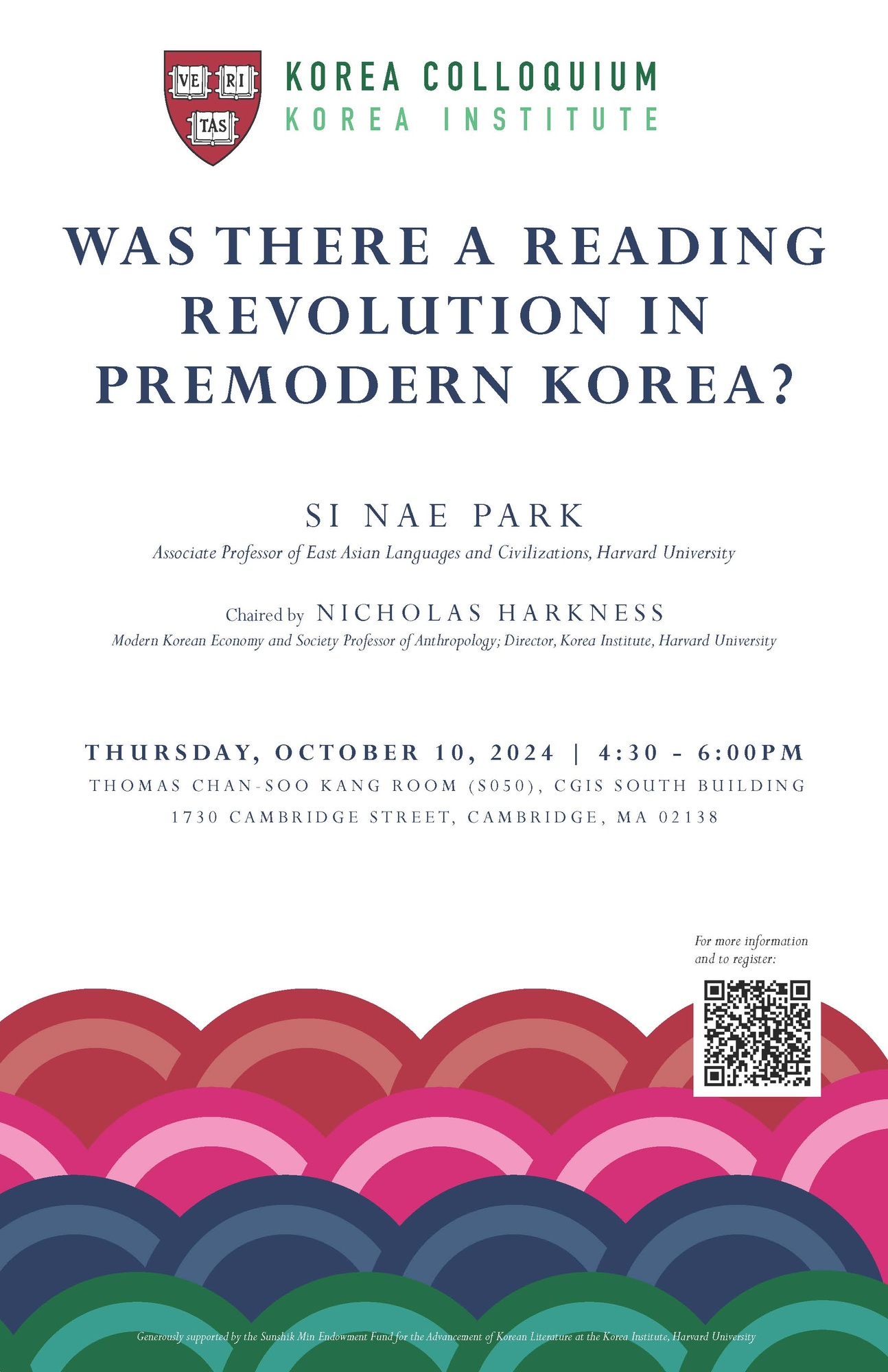time zone will be applied.
Report this post?

Date: Thursday, October 10, 2024, 4:30pm to 6:00pm
Location: Thomas Chan-Soo Kang Room (S050), CGIS South Building, 1730 Cambridge Street, Cambridge, MA 02138
Korea Colloquium
Si Nae Park is an Associate Professor of East Asian Languages and Civilizations at Harvard University. She holds a PhD from the University of British Columbia. She is the author of The Korean Vernacular Story: Telling Tales of Contemporary Chosŏn in Sinographic Writing (Columbia University Press, 2020) and co-editor of Score One for the Dancing Girl and Other Selections from the Kimun ch’onghwa: A Story Collection from Nineteenth-century Korea (University of Toronto Press, 2016). Her works have appeared in the Harvard Journal of Asiatic Studies and East Asian Society and Publishing. Her research centers on the historicity of Korean literature and literary culture in relation to the ecology of inscriptional practices and the book world.
Chaired by Nicholas Harkness, Modern Korean Economy and Society Professor of Anthropology; Director, Korea Institute, Harvard University
Abstract:
In her new book project, Writing as Utterance: Reading Revolution, Plural Scripts, and Literature in Chosŏn Korea, Si Nae Park brings fresh insights to the culture of reading in premodern Korea, by focusing on how changes in the glossing of revered texts had a consequential impact on the life of reading in Chosŏn Korea (1392–1897). Now called kugyŏl, glossing in Korea arose in the seventh century as a reading technology to resolve linguistic, especially grammatical-syntactic, differences between Literary Sinitic and vernacular Korean. The method was based on chirographic interlinear annotation using a variety of symbols that show readers where and how to apply particles, verb-endings, and word order inversion for the purpose of parsing and construing Sinitic texts. After some centuries, kugyŏl evolved to operate in a more streamlined and less granular way, abandoning word order inversion, and lived on its updated form throughout the Chosŏn period until the early twentieth century. The shift in glossing practice was not abrupt, but its implementation was so thorough to the point that even the very memory of the earlier more robust glossing method was forgotten until it was reclaimed after the discovery of a glossed fragment from early Koryŏ inside the belly of a statue of the Buddha in the 1970s.
If previous scholarship has asked questions about the linguistic nature of streamlined kugyŏl glossing compared with its predecessor, Park argues that sufficient textual data and research have accumulated to make it possible to now ask impact-oriented questions. In this presentation, Park discusses the streamlined glossing as a technology of reading, the textual and publishing apparatuses that facilitated its effective spread, and the sociocultural and ideological forces that endorsed the streamlined glossing as received knowledge. Park argues that the new streamlined glossing in Chosŏn assimilated Literary Sinitic into Korean in a radically new way, allowing Literary Sinitic to remain as an entirely translocal written medium of authoritative books while at the same time functioning to fully localize Sinitic texts as utterable, hearable, and more easily manipulable linguistic units in the Korean language. Answering the provocative question Was there a reading revolution in premodern Korea? in the affirmative with her study of the culture of reading in Chosŏn Korea, Park discusses three textual artifacts to demonstrate how changes in glossing retuned the sound of knowledge, reshaped perceptions of literacy, and created a new template for acquiring literary erudition and demonstrating literary innovation. This presentation concludes by asking how this site-specific exploration of how the act and materiality of reading reconfigured the textual condition and changed the life of texts can enrich our understanding of comparative literary histories.
***
Generously supported by the Sunshik Min Endowment Fund for the Advancement of Korean Literature at the Korea Institute, Harvard University
For more information, visit the website here